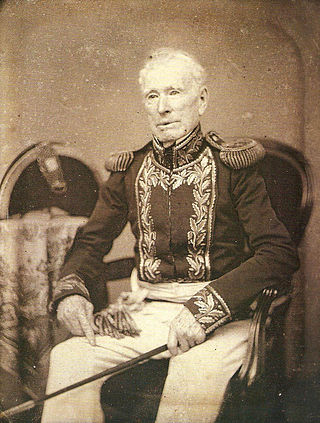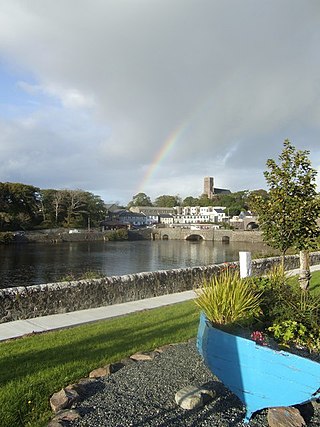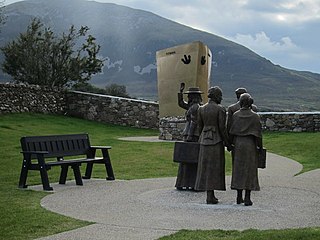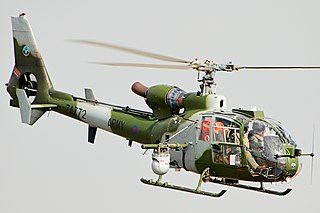
County Mayo is a county in Ireland. In the West of Ireland, in the province of Connacht, it is named after the village of Mayo, now generally known as Mayo Abbey. Mayo County Council is the local authority. The population was 137,231 at the 2022 census. The boundaries of the county, which was formed in 1585, reflect the Mac William Íochtar lordship at that time.

William Brown was an Irish sailor, merchant, and naval commander who served in the Argentine Navy during the wars of the early 19th century. Brown's successes in the Argentine War of Independence, the Cisplatine War and the Anglo-French blockade of the Río de la Plata earned the respect and appreciation of the Argentine people, and he is regarded as one of Argentina's national heroes. Creator and first admiral of the country's maritime forces, he is commonly known as the "father of the Argentine Navy".

Castlebar is the county town of County Mayo, Ireland. Developing around a 13th-century castle of the de Barry family, from which the town got its name, the town now acts as a social and economic focal point for the surrounding hinterland. With a population of 13,054 in the 2022 census, Castlebar was one of the fastest growing towns in Ireland in the early 21st century.
1798 was a relatively quiet period in the French Revolutionary Wars. The major continental powers in the First coalition had made peace with France, leaving France dominant in Europe with only a slow naval war with Great Britain to worry about. The leaders of the Directory in Paris feared Napoleon Bonaparte's popularity after his victories in Italy, so they were relieved when he proposed to depart France and mount an expedition to Egypt to gain further glory.

Newport, historically known as Ballyveaghan and for many years also known as Newport-Pratt, is a small town in the barony of Burrishoole, County Mayo, Ireland. The population was 626 in 2016. It is located on the west coast of Ireland, along the shore of Clew Bay, north of Westport. The N59 road passes through the town. The county town of Castlebar is approx 18 km east of Newport. The Black Oak River flows through the centre of the town and there are walking paths along its banks.

Gerard Lake, 1st Viscount Lake was a British general. He commanded British forces during the Irish Rebellion of 1798 and later served as Commander-in-Chief of the military in British India.

Lahardane, also sometimes spelled Lahardaun, is a village in the parish of Addergoole, County Mayo, Ireland, adjacent to Lough Conn and to Nephin, and close to the towns of Crossmolina, Castlebar and Ballina. The 2016 census recorded a population of 178.

The Battle of Castlebar occurred on 27 August 1798 near the town of Castlebar, County Mayo, during the Irish Rising of that year. A combined force of 2,000 French troops and Irish patriots routed a combined force of 6,000-strong British and Protestant loyalist militia troops led by Gerard Lake, 1st Viscount Lake in what would later become known as the "Castlebar Races" or "Races of Castlebar".

The Gallagher family of County Donegal, formerly one of the leading clans of Cenél Conaill, and therefore of all Ulster, originated in the 10th century as a derivative of their progenitor Gallchobhar mac Rorcain, senior-most descendant of Conall Gulban, son of Niall Mór Noigíallach. The O'Gallaghers held the High Kingship of Ireland during the early medieval period. They also held the rank of hereditary Marshal of the Kingdom of Tyrconnell, ruled by their kinsmen the O'Donnells, from the 14th until the early 17th century.
This is a timeline of the Irish Civil War, which took place between June 1922 and May 1923. It followed the Irish War of Independence (1919–1921), and accompanied the establishment of the Irish Free State as an entity independent from the United Kingdom of Great Britain and Ireland.

The Battle of Collooney, also called the Battle of Carricknagat, refers to a battle which occurred on 5 September during the Irish Rebellion of 1798 when a combined force of French troops and Irish rebels defeated a force of British troops outside of Collooney near Sligo Town.

The Battle of Killala was an engagement during the Irish Rebellion of 1798. It was fought on Sunday, 23 September 1798, between forces of the British Crown and a combined force of Irish rebels and a small number of French troops at Killala, County Mayo, Ireland.
Padraig Gearr Ó Mannin was a United Irishman who participated in the Irish Rebellion of 1798 in County Mayo.
Henry O'Keane was an Irish catholic priest and French army officer.

On 17 February 1978, a British Army Gazelle helicopter, serial number XX404, went down near Jonesborough, County Armagh, Northern Ireland, after being fired at by a Provisional IRA unit from the South Armagh Brigade. The IRA unit was involved at the time in a gun battle with a Green Jackets observation post deployed in the area, and the helicopter was sent in to support the ground troops. The helicopter crashed after the pilot lost control of the aircraft whilst evading ground fire.
John Maughan is an Irish Gaelic football manager and former player who most recently managed the Offaly football team.
Timothy Brecknock was an eccentric lawyer and writer. After studying at Oxford and Lincoln’s Inn, he embarked on a career in London that was mired in controversy. In later life, along with his employer, George Robert FitzGerald, he was executed for conspiracy to murder, in Castlebar, County Mayo in 1786, although he vigorously denied the charge.

Ballina is a town in north County Mayo, Ireland. It lies at the mouth of the River Moy near Killala Bay, in the Moy valley and Parish of Kilmoremoy, with the Ox Mountains to the east and the Nephin Beg mountains to the west. The town occupies two baronies; Tirawley on the west bank of the Moy River, and Tireragh, a barony within County Sligo, on its east banks. At the 2022 census, the population of Ballina was 10,556.
Barnard Foord Bowes or Barnard Bowes Foord commanded a British brigade in several battles during the Peninsular War. He joined the 26th Foot Regiment as a junior officer in 1781 and rose in rank by purchase to become lieutenant colonel of the 6th Foot Regiment in 1796. He led troops during the Irish Rebellion of 1798. From 1799 to 1806 he served in Canada and married his wife there. He led a brigade at Roliça and Vimeiro in 1808. He was promoted major general in 1810. He was severely wounded while leading his brigade in an assault during the 1812 Siege of Badajoz. He was killed in action leading a storming column at the Siege of the Salamanca Forts.
The Holywell ambush was an ambush on the Ballyhaunis to Claremorris road near Holywell in the early hours of Monday, 2 August 1920 carried out by the Irish Republican Army (IRA) during the Irish War of Independence. Approximately 20 local IRA volunteers commanded by Patrick Kenny attacked a British Military outpost that was guarding a broken down lorry.











